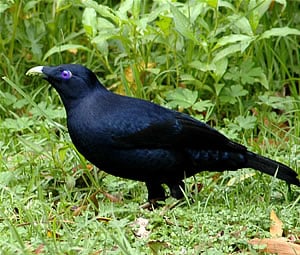
May 22, 2008
The Metropolis Conference@ICFF: Fritz Haeg
A crowd gathers to hear the Edible Estates author speak during the first annual Horace Havemeyer III Lecture.
Fritz Haeg at ICFF on Monday.
Have you ever wondered what goes on in the mind of Fritz Haeg? The multi-talented artist, architect, writer, and activist has received so much media ink these days for his diverse work around the country and on Monday morning, he offered a large crowd at ICFF insight into that creative process. Haeg kicked off the Metropolis conference with the first annual Horace Havemeyer III keynote by speaking about his popular Edible Estates and Animal Estates projects and the underpinnings of his work. “I’ve become obsessed with two things,” he said, “our relationship to our environment and our relationship to other people.”
Haeg scrolled through slides of performance art by Mierle Laderman Ukeles, quilts and textiles from the Shaker community, and other works by artists and artisans who influenced his trajectory. For Haeg, their work brings to light processes, materials, and objects that we generally overlook, like trash and discarded rags. He parallels their ability to transform refuse into something fruitful to his own act of creating compost piles in his edible front yards. The more our culture fetishizes materials and objects, he explained, the more it disposes, resulting in human contamination of our purer states.
The male satin bowerbird. Photo by Brett Donald.
He referenced the bowerbird as an animal that inspired his thinking. The male of the species puts on a show to attract female birds by creating a temporary, colorful stage. The bird collects jettisoned objects like bottle caps, string, and other bird feathers and, after a successful courtship, returns the objects to the exact spot where he found them. Similarly, Edible Estates brings beauty to vital functions. It draws the community together, enhancing our personal bonds while reforming our relationships with the environment and our neighbors. It forces us to think twice about what we throw into the earth, as it will come back to grow in our own front yard.
Haeg titled his talk “Things Fall Apart,” in reference to William Butler Yeats’ seminal poem The Second Coming. Written in the wake of World War I, Yeats wrote how “Things fall apart; the centre cannot hold.” The second coming for Haeg is more optimistic than Yeats’ beast slouching towards Bethlehem; for him it appears as a vitality in art and design and is reincarnated as his myriad repertoire. Haeg, too, sees that the center cannot hold, but hopes that through our shared work we can begin to reclaim the ties that bind us to the earth and to one another.
You’ll be able to see and hear more from Haeg yourself in the coming weeks when we post edited video of the conference on the site.





